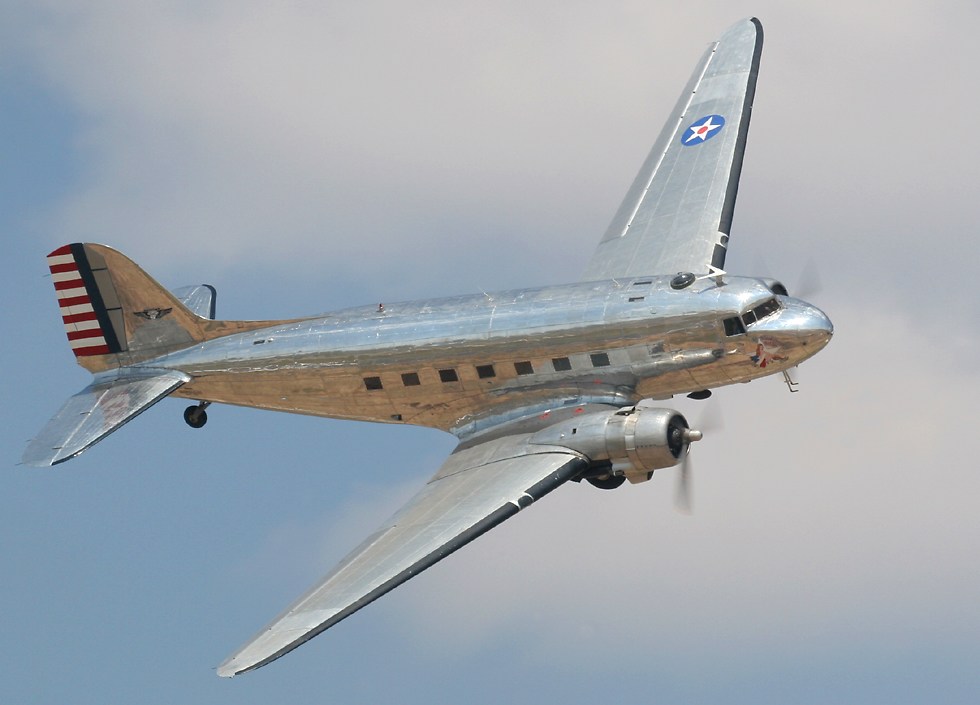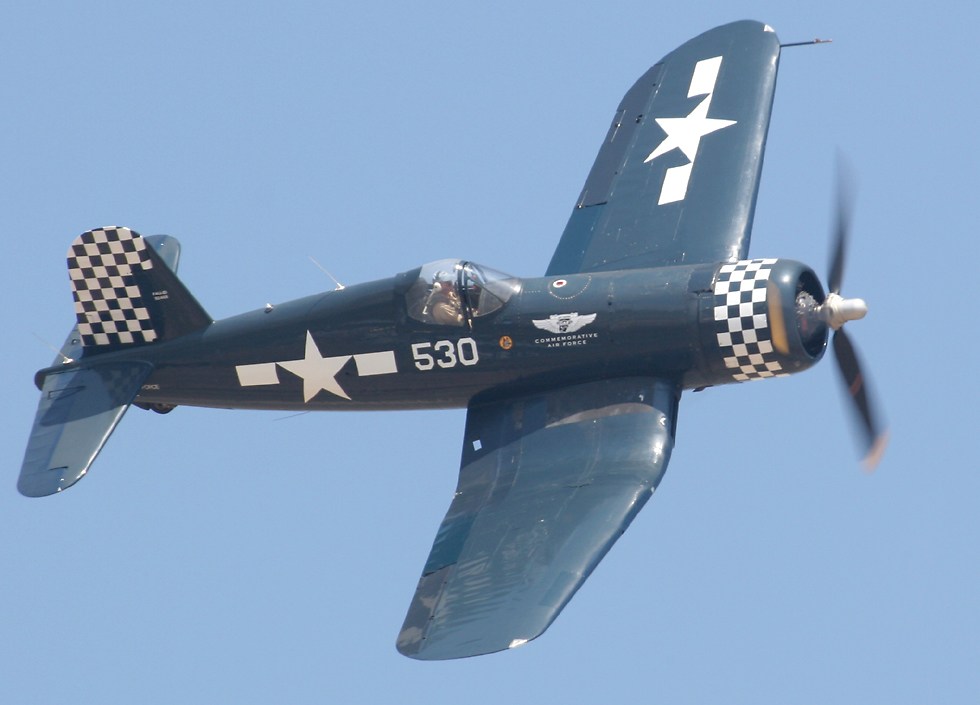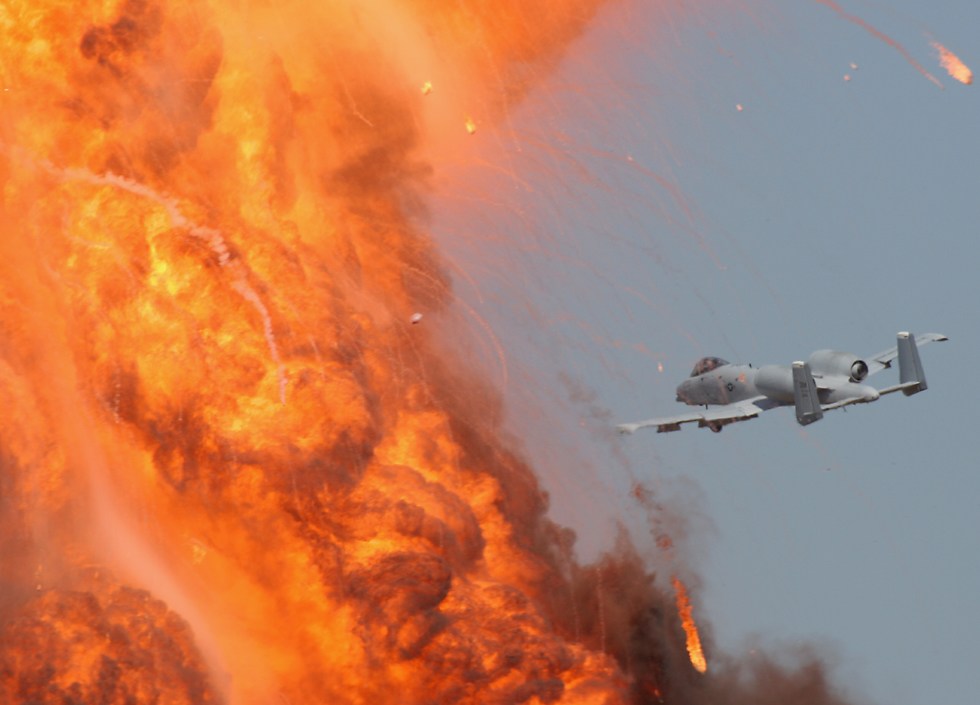Midland CAF Airshow 2008
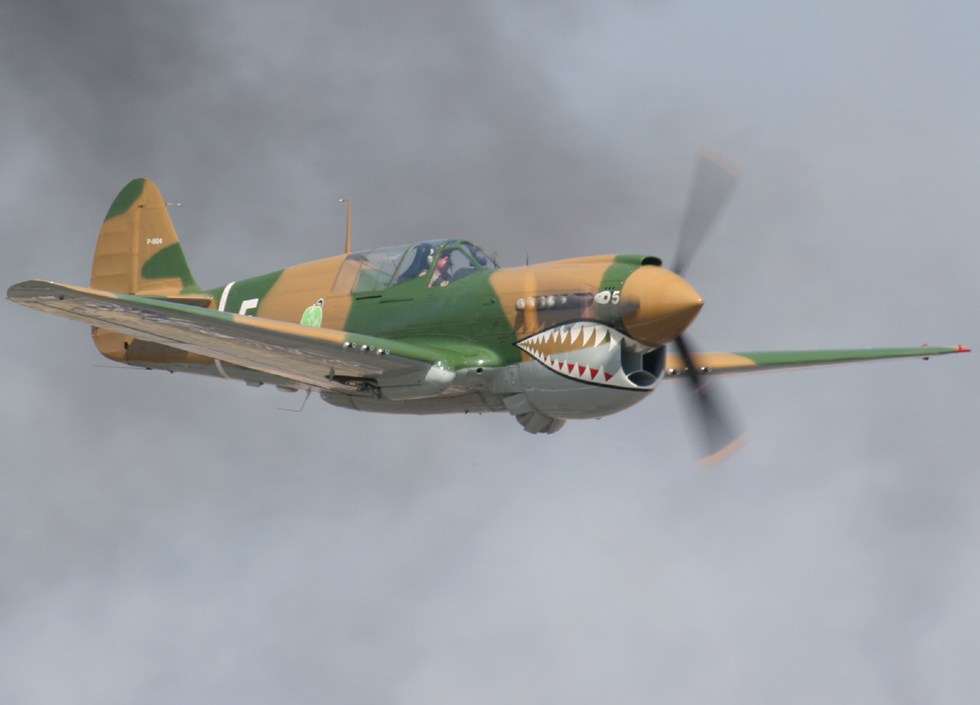
The 2008 airshow held at the CAF's home base in Midland, Texas, had the usual mix of good weather, good aircraft and good pyrotechnics. Unfortunately, 2008 isn't going to be remembered as one of the great years on the airshow circuit. The price of oil doubled in less than a year, reaching a peak of $US147 a barrel, which meant a greatly reduced number of aircraft at most shows and outright cancellations of other shows. Weather also had an impact, making shows like the Yankee Air Museum's "Thunder Over Michigan" less than ideal for photography, though the effect was even more pronounced on the world's largest military airshow, the Royal International Air Tattoo (RIAT) held in the UK, whose grounds were flooded so badly that the show had to be cancelled. The Midland show certainly didn't suffer bad weather during the show days, but a couple of hurricanes which blew through Texas in the preceeding weeks did lead to cancellations and, combined with the high fuel prices, this meant that the visiting aircraft ramp had about half as many aircraft as last year. Still, this is one of the world's largest warbirds shows, so there was still plenty to see, like this P-40 Warhawk, an aircraft type which isn't especially common nowadays. |

This P-39 Airacobra is even less common, it's one of only three which are still flying anywhere. One of the nice things about Midland is that many of the takeoffs and landings happen on the runway in front of the crowdline. It also doesn't hurt that in a nice bit of serendipity I happened to take this shot just as the Airacobra passed in front of a world war two style jeep which some of the pyro crew had taken onto the field. The Bell P-39 entered service in 1941. Together with its larger derivative the P-63 Kingcobra, it was the only single engine American fighter with tricycle undercarriage, though two engine fighters like the P-38 Lightning, P-61 Black Widow and F7F Tigercat also had this configuration. The Bell aircraft was also unusual in having an engine mounted behind the pilot, with a driveshaft running between his legs, and having a 37mm cannon which fired through the propeller spinner. Many other nations such as the British, Germans and even Japanese had cannon armament, but the United States mostly stayed with .50 caliber machine guns, right through to the F-86 Sabre jet. |
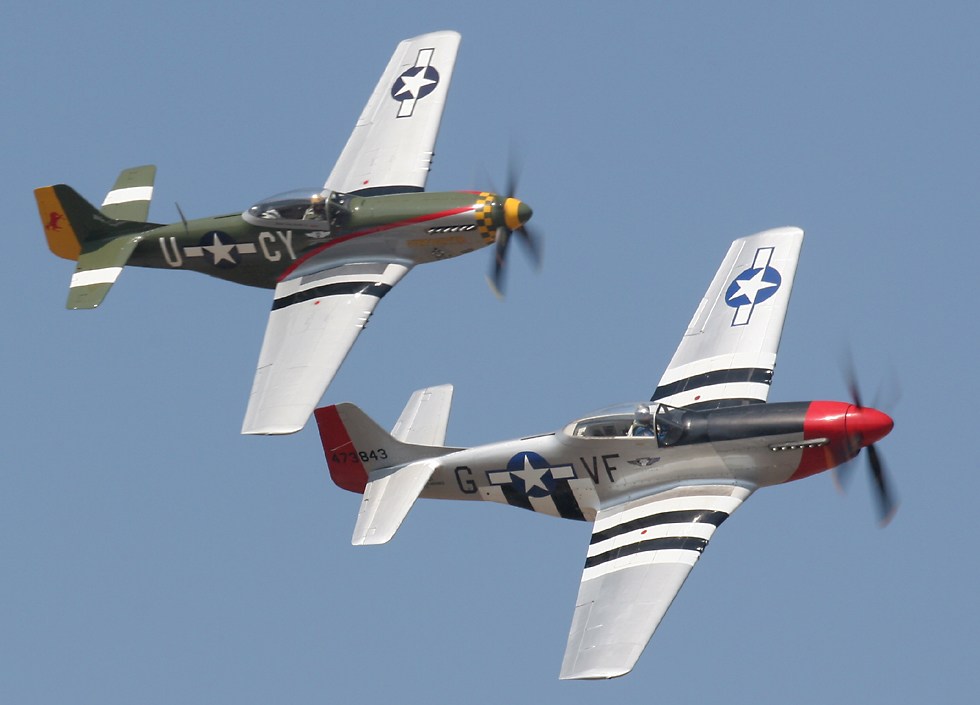
It was very nice to see the P-39 and the P-40, which aren't at the show every year, but as with almost all American airshows you're pretty much guaranteed to see the P-51 Mustang, which was the premier American fighter of the war. This year's show featured a very nice, tight formation with "Red Nose", the first aircraft in the Commemorative Air Force collection, and "Gunfighter". |
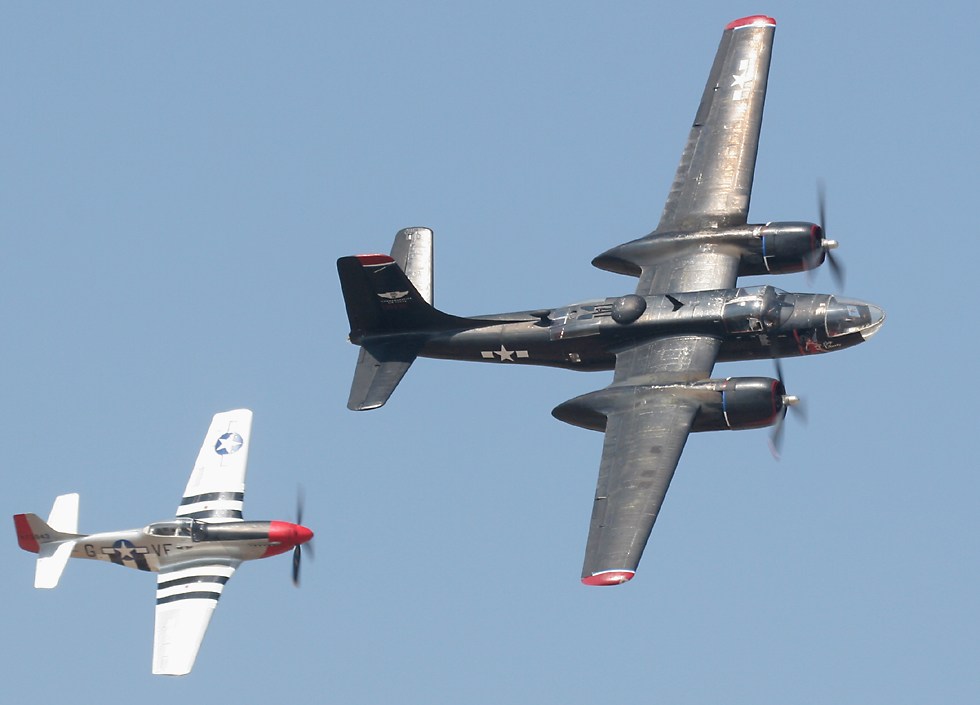
Red Nose also got into the act with a much less commonly seen aircraft, the A-26 Invader. The Invader was a very fast light bomber with only a single pilot and navigator/bombardier, as well as gun turrets above and below the fuselage which were remotely operated by a third crewman. This particular aircraft has a clear "bombardier" nose, but other versions were fitted with a solid nose carrying eight .50 caliber guns, which together with three more .50 caliber guns in each wing gave a formidable ground-strafing armament of 14 machine guns. In a confusing move after the war, the air force changed the Invader's designation to the same B-26 designation that had previously been applied to the Marauder medium bomber. The Invader served during the Korean war and then operated with the French during their Indochina war. They were then used by the USAF from Thailand and Laos, and upgraded variants operated in Vietnam. However these were redesignated back to A-26, because Thailand didn't want bombers to be operated from their territory against other countries! |
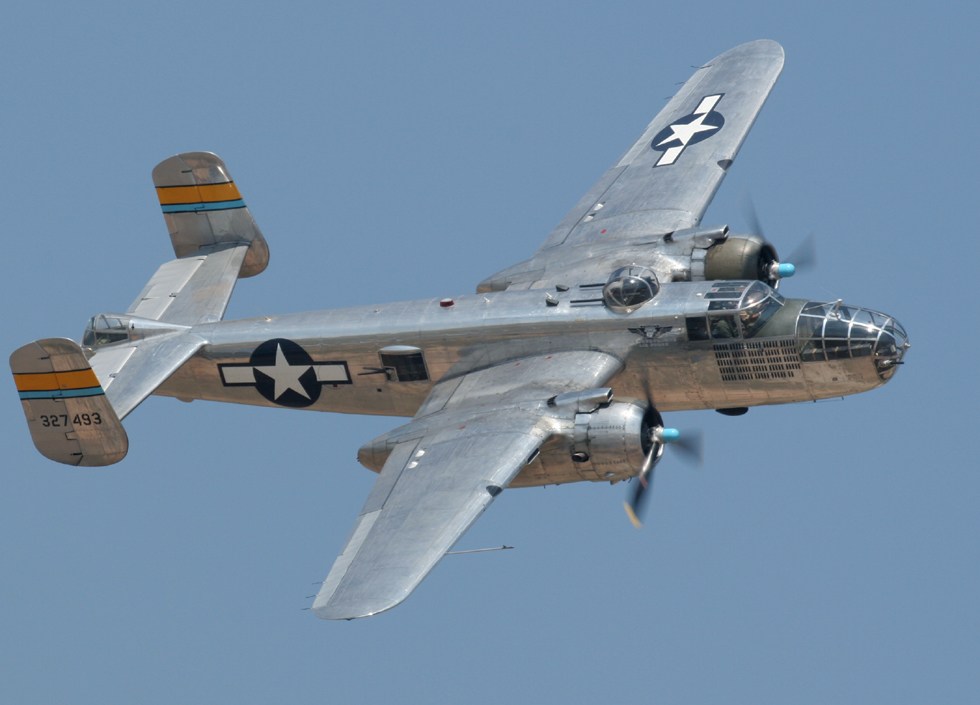
"Miss Mitchell" is a B-25J Mitchell bomber operated by the Southern Minnesota wing of the Commemorative Air Force. Restoration began in the 1980s and it was painted in the color scheme of an aircraft which flew 140 missions during the war. |

Here's the B-17 Flying Fortress "Sentimental Journey" on a simulated bombing run, with pyrotechnic smoke in the background. Introduced in 1938, the Flying Fortress was the best heavy bomber of the first part of the war, but by later standards it had a fairly small bombload. Early models carried only 4,000 pounds of bombs, but later models could carry up to 12,000 pounds on short range missions, constrained both by the weight and by the small size of the bomb bay. In contrast, the Lancaster was the main bomber of the Royal Air Force and had a 33 foot long bomb bay, allowing typical loads of 14,000 pounds, compared to a typical load of 5,000 pounds for the Flying Fortress. With modifications the Lancaster could even carry a single 25.5 foot long, 22,000 pound Grand Slam "earthquake bomb". |

It was nice to see the B-17 in formation with a couple of "Little Friends", though I think we know that those P-51s can fly a tighter formation than this! The Flying Fortress and the Mustang captured the hearts and minds of the American public during the war, which is one reason why so many of both of them are still flying. Although the bombload was somewhat lacking by later standards, the large fleet of Flying Fortresses flew many missions over a long period of time, and ultimately dropped 640,000 tons of bombs over Europe, which was more than any other American aircraft. They did this during the daytime against heavy opposition, whereas Lancasters flew mostly at night, dropping almost 610,000 tons of ordnance. The Flying Fortress was loved not just by the public, but also by its crews. It could survive enormous battle damage, some coming home with their entire nose or tail blown off, or with huge holes in the wings and fuselage. If it was shot down then it was much easier for the crew to escape than the crew of a Lancaster, few of whom survived. |
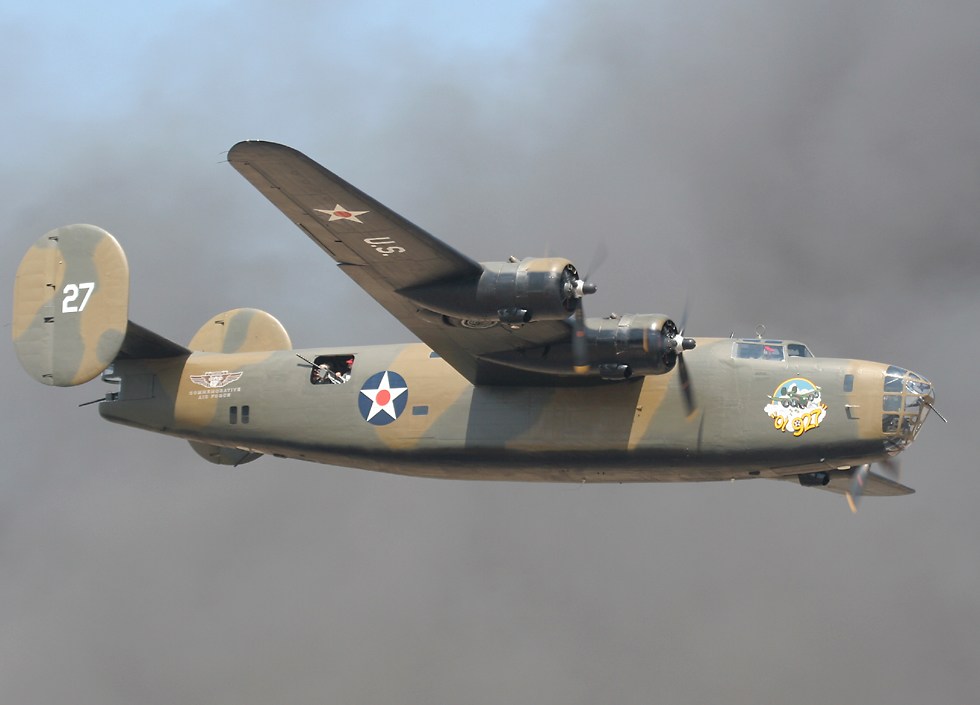
The B-24 Liberator was much less well known than the Flying Fortress amongst the American public in world war two, and that's still true today, which helps explain why there are only two in the world which are flying. As you can see, this is "Ol' 927", which until recently flew as an LB-30 cargo variant of the Liberator called "Diamond Lil". It's certainly a lot better to see it fly in this configuration, as an early model B-24A bomber. The "A" model lacked both the belly turret and powered nose turret of later models, and it had supercharged engines rather than turbocharged engines, so the engine nacelles are round instead of the distinctive horizontal oval nacelles of the later turbocharged models. |
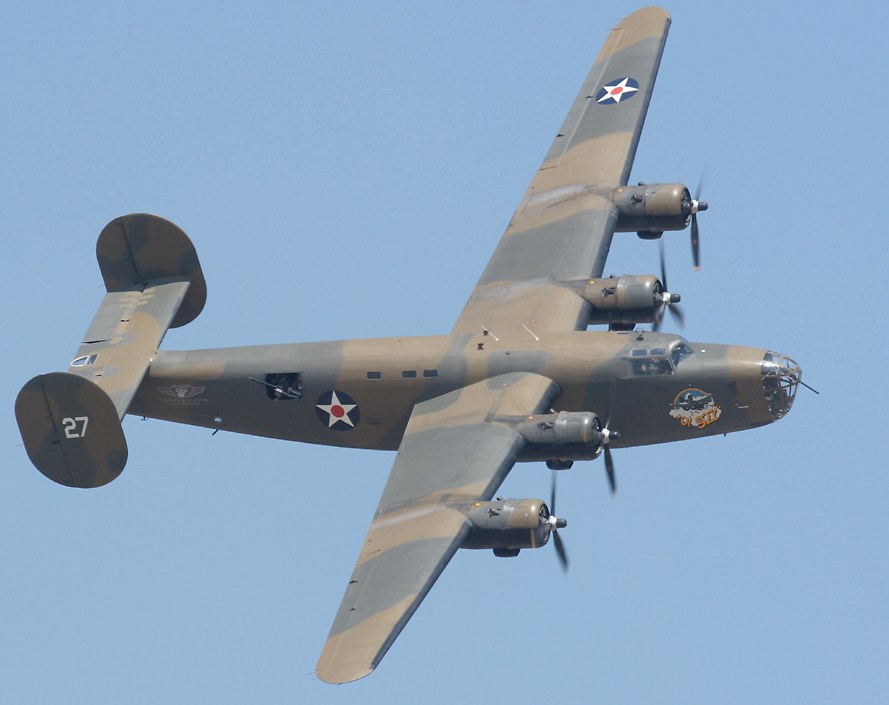
Most people don't realize that a lot more Liberators were built than Flying Fortresses, a total of 18,482 compared to 12,731 for the B-17. This makes the Liberator the American military aircraft produced in the largest numbers, a record it holds until this day. The Liberator could carry a significantly higher bombload than the Flying Fortress, its cruising speed was 215mph compared to 182mph for its older cousin, and its combat radius was also greater, which made it very suitable for long distance raids as well as maritime patrol, which is how the British used it. In this role Liberators sank 72 U-boats, dramatically shrinking the "Mid-Atlantic gap" at a vital time in this critical arena. One reason for the Liberator's improved speed was its innovative "Davis wing", which was much narrower than the B-17's wing. However in spite of the Liberator's speed advantage, the Flying Fortress remained the more popular aircraft with aircrews, because it could take more battle damage, and if shot down the Liberator crew, just like those on the Lancaster, had to exit near the rear of the aircraft, which made it much harder for crewmen in the forward part of the plane to escape. |
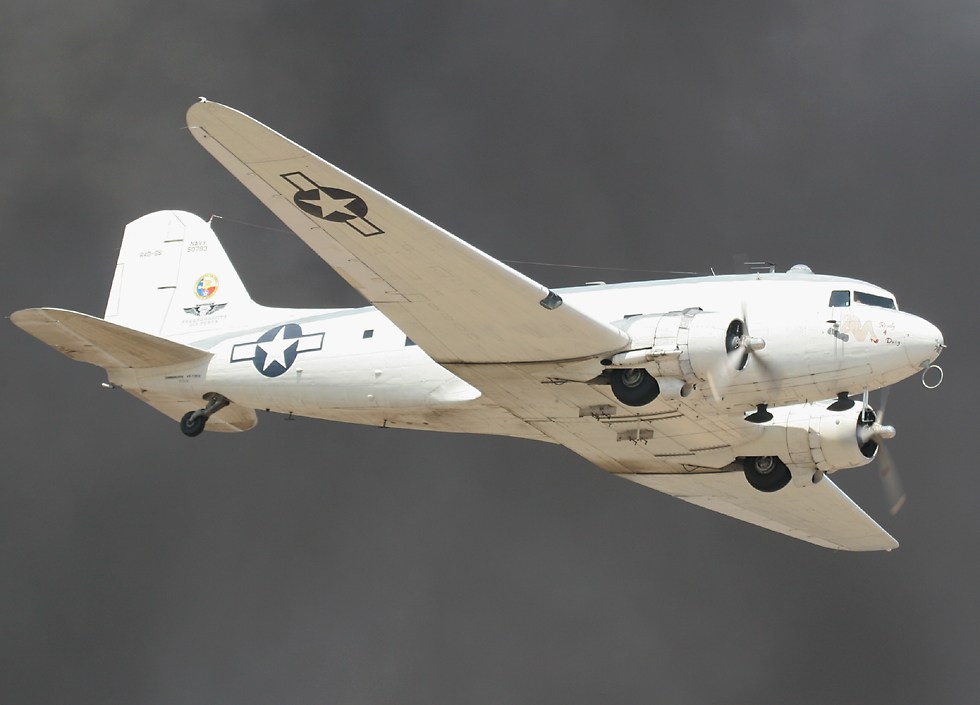
It's not well known that the US navy had its own version of the Dakota, called the R4D, which was also used by NASA. This is the only one I know of on the airshow circuit, its nose art suggests that "R4D" is short for "ready for duty"! There were several versions of the R4D, this particular aircraft was one of only 30 configured as one of the more interesting variants, the R4D-6S, which was used for anti-submarine warfare. You can still see the antennas for the early air-to-surface radar below the side cockpit window, as well as under the rear fuselage. There are also racks for bombs or depth charges under the center section of the wing. |
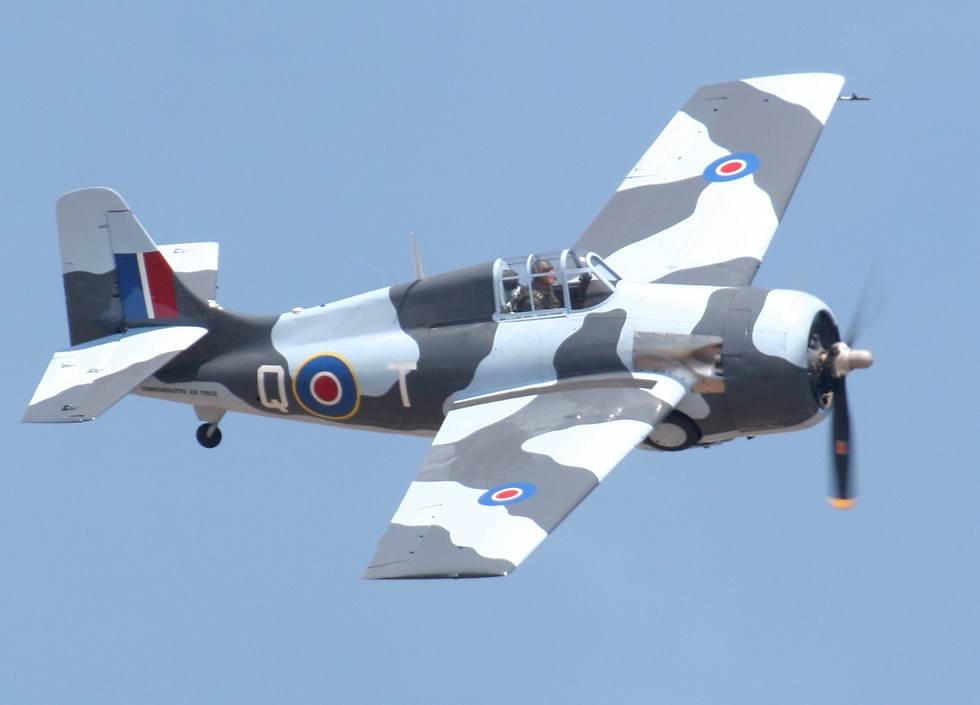
Midland always has a very good selection of vintage naval aircraft flying, like this FM2 Wildcat painted in a British scheme, where it was originally called the "Marlet". A Marlet was the first American-made plane to shoot down a German plane during world war two, a Ju 88 bomber intercepted by the British in December of 1940 at the Scapa Flow naval base in Scotland. It was nice to see an acknowledgement of the international efforts which were made during the war, but it was very annoying to have one of the announcers say several times each show day that America "gave" the aircraft to the Allied forces. Actually America sold the equipment to them, and it wasn't until 2005 that Great Britain finished paying all of the American debt it incurred during the war. No doubt, though, many people left the show with this misconception firmly embedded in their minds. |
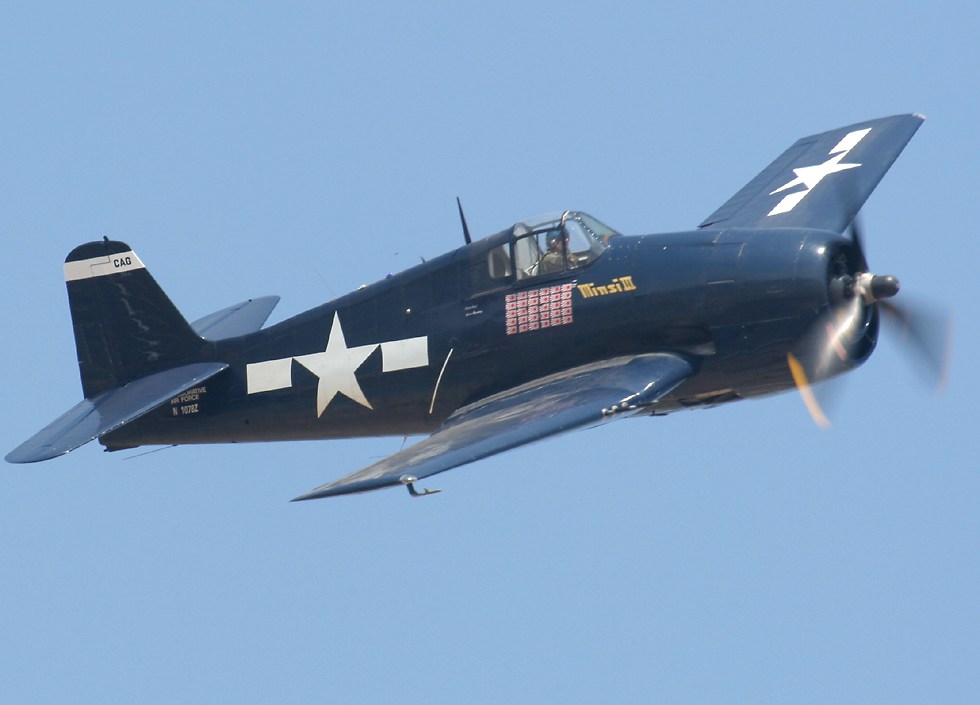
The Wildcat was the navy's main fighter when the war began, but it had difficulty coming to grips with the faster and more nimble Japanese Zero fighter. The Wildcat's main saving grace was its armor, which frequently allowed it to live to fight another day; in contrast the Zero lacked self-sealing fuel tanks and adequate armor, so it was relatively easy for a Wildcat pilot to shoot it down, as long as he could get it in his sights. Grumman, the manufacturer of the Wildcat, responded by developing the F6F Hellcat specifically as a Zero killer, with a 2000 horsepower R2800 Double Wasp engine which ensured its dominance over the Japanese aircraft. The Hellcat went on to become the most successful naval fighter of all time, shooting down 5163 Japanese aircraft, which was a full 75% of the American total in the Pacific. Night fighter versions with radar flew in combat from the end of 1943, and after world war two they were used by French forces in Indochina. |
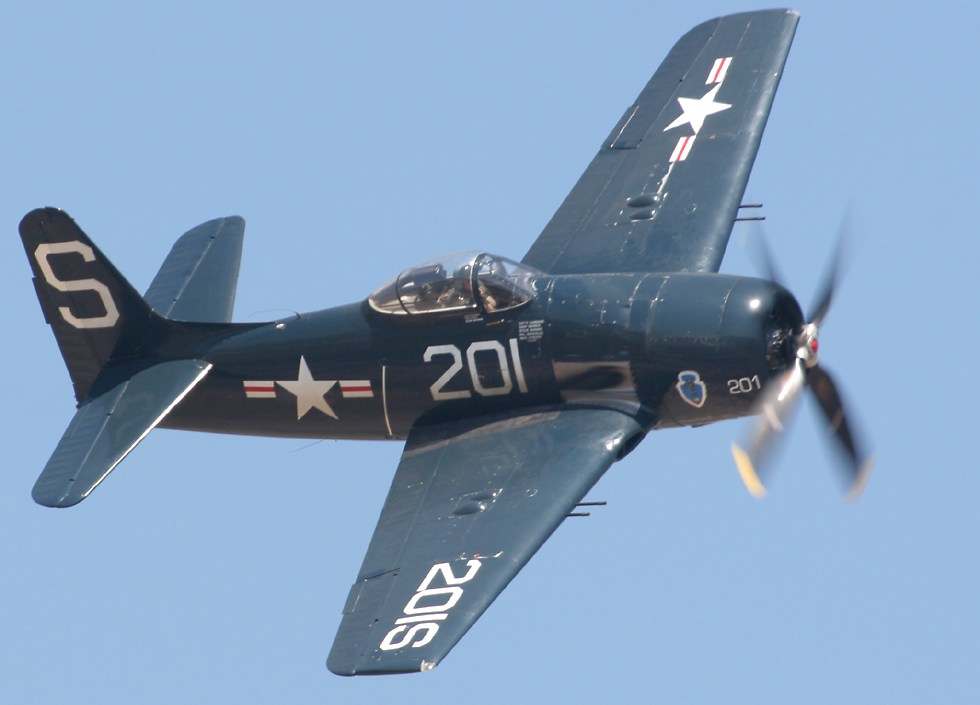
Grumman produced the F8F Bearcat as a replacement for the Hellcat, but it arrived just too late to fight during world war two. It was a significant improvement, with a bubble canopy providing much better rear visibility and four 20mm cannon for increased firepower compared to the Hellcat's six 0.50 caliber machine guns. It was much lighter than its predecessor and with the R2800 driving a four-bladed propeller, it could climb much faster, which was an important consideration because of the increasing number of kamikaze attacks from high altitude. The French used the Bearcat in Indochina, and the Thai air force also operated a large number of them. It became popular in American civilian circles, flying in the Reno air races, sometimes in highly modified forms like the plane called Rare Bear. |
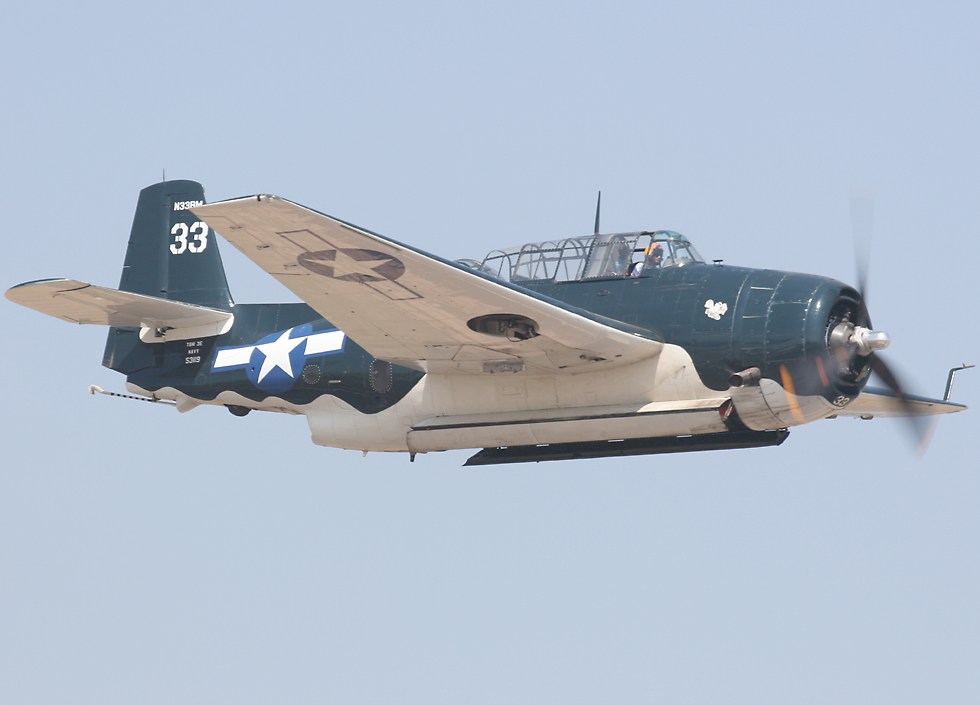
Here's another Grumman aircraft, the TBM Avenger. The previous three aircraft were all fighters, but the Avenger is a bomber, carrying either regular bombs or a torpedo in the bomb bay you can see being demonstrated in this shot. The Avenger is one of the aircraft which lead to Grumman receiving the nickname "The Iron Works", because of the robustness of their planes. The Avenger's first combat experience was appallingly bad, a flight of six of them was intercepted during the Battle of Midway by a large formation of Japanese fighters. Five were shot down, but the surprising thing is that one was able to return to base, even though it had 70 cannon and bullet holes and its hydraulic system and elevator controls were destroyed. The first President Bush flew an Avenger during the war, he was one of the youngest naval pilots when he started service, and survived after his plane was shot down off the island of Chichi Jima. |
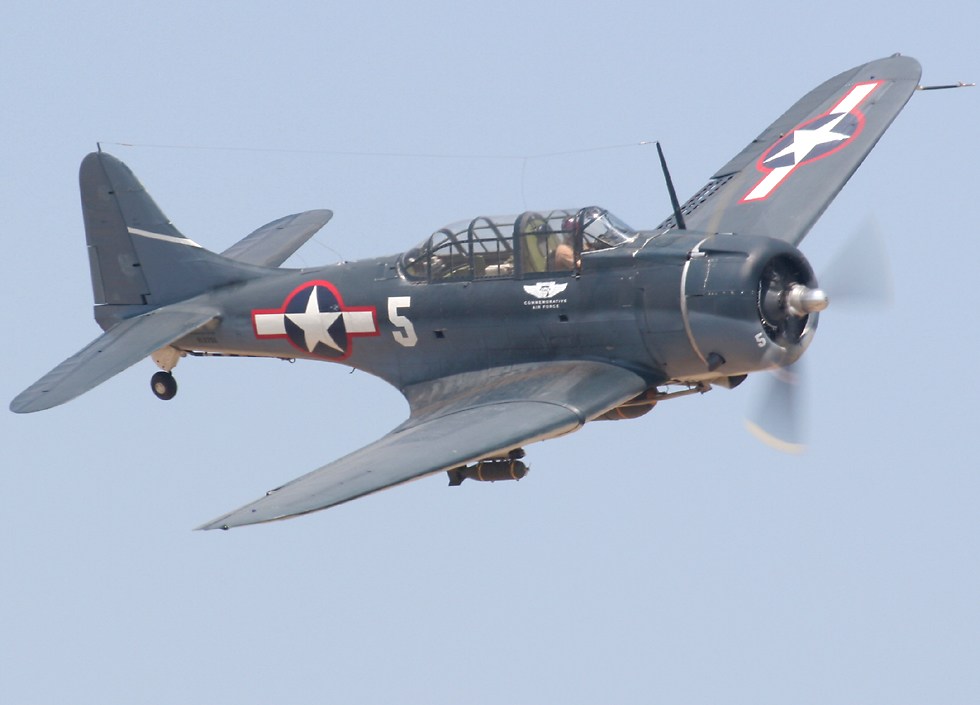
As the war progressed, Grumman became the dominant supplier of naval aircraft, and remained a major player after the war, through the jet age, and finally into the 1970s with the F-14 Tomcat fighter, before being bought by the Northrop Corporation to become Northrop Grumman. However other companies also produced a string of successful aircraft for the US navy, before, during and after world war two. One of these companies was the Douglas Corporation, which not only designed and manufactured the C-47 Skytrain and A-26 Invader, but also naval types like this Dauntless dive bomber and A-1 Skyraider, which you'll see later on this page. Dive bombers were a respected aircraft type before the war, and the German Stuka attained almost legendary status in the early fighting against Poland and other countries. However when attacking the British home islands it became clear that it was very vulnerable to modern fighters, so the Allies decided not to pursue this aircraft type, except for brief forays by aircraft like the A-36 Invader, which was an early model Mustang optimized for this role. Few people now realize that the US army air force also had 948 Dauntlesses, which were called the A-24 Banshee. Dive bombers played a much more significant role in the Pacific war, because of their ability to hit small targets like ships. The Dauntless was very successful, sinking more Japanese shipping than any other aircraft, the Dauntless' total including the four Japanese aircraft carriers involved in the Battle of Midway. With two forward-firing .50 caliber machine guns and one or two .30 caliber machine guns operated by the rear gunner, the Dauntless was also surprisingly effective at self-defense, and eventually they had a better than 1:1 kill ratio against enemy fighters. These attributes earned the plane the nickname, based on its SBD designation, of "slow but deadly". |
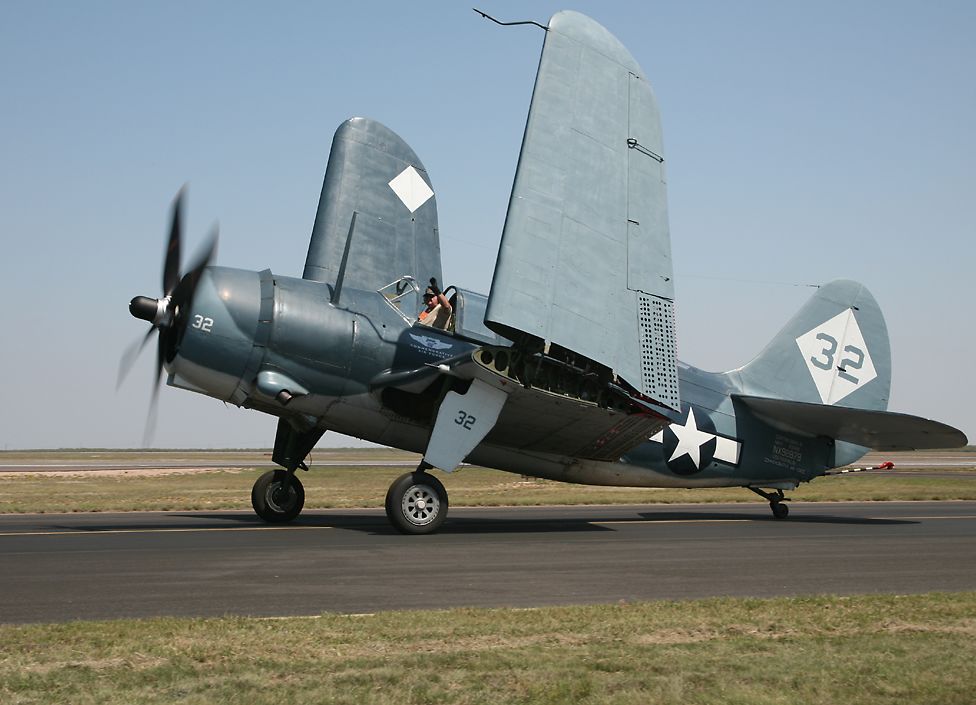
The replacement for the Dauntless was the Curtiss SB2C Helldiver, a much larger aircraft but with a much less desirable nickname, "Son of a Bitch, 2nd Class". In spite of its size, the Helldiver was faster than the Dauntless, but it had a reputation for having worse handling characteristics, which is a particular issue with a carrier-borne aircraft. It also had shorter range than the Dauntless, which is a bit disconcerting when you're spending a lot of time flying over vast expanses of water. |
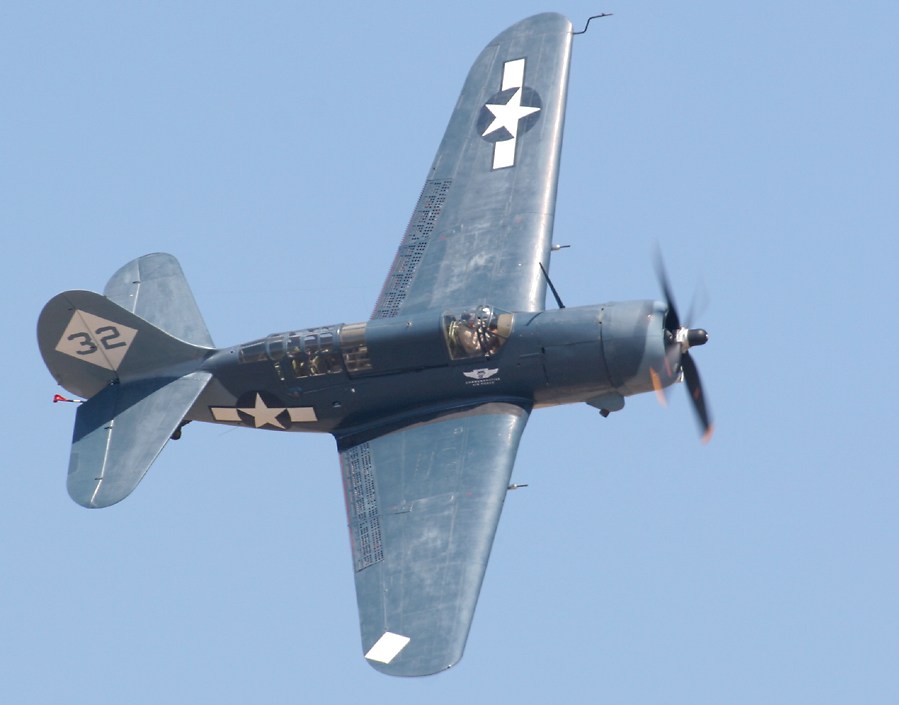
The Helldiver suffered from structural problems throughout its lifetime, the second prototype crashed when it pulled out of a dive and the starboard wing and tailplane broke off, and when it entered service following a very prolonged development, pilots were forbidden to dive bomb unless the dive brakes were deployed, because of the risk of breaking apart. The army air force also order 900 of these aircraft, designated as the A-25 Shrike, but they decided not to use them. Instead they were offered to Australia, who took 10 of them and then refused to take any more, resulting in the other 410 being sent to the US marines. The British also ordered 450, but after receiving 26 they decided that the aircraft had "appalling handling" and cancelled the order. This is the only Helldiver which is still flying, and though it wasn't one of the war's great aircraft, it's still terrific to see this type in operation. |

In the early part of the war the British lacked top-rate naval fighters, using either clumsy aircraft like the Fairey Fulmar, or modified land-based fighters like the Sea Hurricane and Supermarine Seafire. The British made up for this lack by using American aircraft like the Wildcat, Hellcat and Corsair; however they continued developing their own high-performance aircraft like this Sea Fury. It's a very clean design, with some features gleaned from the Focke Wulfe Fw 190, but it arrived just too late to participate in the war. The land-based Fury was cancelled but the Sea Fury went into operation and remained the standard British naval fighter until replaced by jets in 1953. During the Korean war one Sea Fury pilot even demonstrated the plane's capabilities by shooting down a MiG-15 jet. The Sea Fury had wide export success, operating with the military services of Australia, Canada, the Netherlands, Germany, Morocco, Egypt, Iraq, Pakistan, Burma and even Cuba. |

All of these aircraft, both air force and navy, perform battle re-enactments along with the replica Japanese aircraft of the "Tora, Tora, Tora" Pearl Harbor re-enactors. This is a very large scale re-enactment, with Zeroes, Val dive bombers and these Kate torpedo bombers (though the front Kate here is carrying a regular bomb). It's a good show, enhanced considerably by the largest pyrotechnics display of any airshow in America. |

As well as all of the world war two action, the show also has a Vietnam era section which centers around the rescue of a pilot downed in hostile territory. This year's airshow website promised an extended Vietnam re-enactment, but in the event there were fewer aircraft flying than in previous years. This was quite disappointing, because this re-enactment is a major highlight of the Midland show which distinguishes it from other shows. The O-2 Skymaster was a forward air controller aircraft during the war. It's an off-the-shelf Cessna, so it lacked even basic armor, yet a pilot would often deliberately fly just above treetop level in order to provoke enemy troops to fire on him, and give away their position. The pilot could then call in ground attack aircraft operating in conjunction with him to attack those troops. The O-2s would sometimes fire small white phosphorus "Willie Pete" to mark the ground targets, and a few O-2s were even equipped with offensive rockets or small bomblets. |

The goal of the Commemorative Air Force is to preserve at least one of every aircraft type used by the US military, so it's no surprise that they don't have much in the way of foreign aircraft. So, to play the role of the Vietnamese aggressor they brought in this L-39 Albatross, which is the current standard Soviet bloc military jet trainer, and wasn't operating during the Vietnam war. It's a very good-looking aircraft which has become popular in the United States, there's even a west coast civilian jet display team called The Patriots, which is ironic considering they're flying a Soviet aircraft! This shot shows it with the speed brakes under the fuselage deployed; if you look forward under the canopy you can see that the pilot has named his plane "Tornado", which is probably why the guy sitting next to me told me that this was a British Tornado fighter/bomber. |

It was good to see a couple of Skyraiders take part in the display. The one on the left is a single-seat air force version, while the one on the right is a navy A-1E; these navy ones also went under older style designations like AD-5 and AD-6, which stood for "Attack" aircraft manufactured by the "Douglas" corporation, model 5 or 6. Although introduced just after world war two, the Skyraider's heavy load carrying capabilities, long loiter time and accuracy in ordnance delivery all made it ideal for the close support role in Vietnam. A pair of Skyraiders even shot down a MiG-17 "Fresco" jet fighter which was foolish enough to engage in a head-on attack. The A-1's capabilities made it especially suitable for the "Sandy" role of providing support for the rescue of a pilot on the ground. The long loiter time allowed the Sandys to remain in the area while waiting for helicopters to arrive for the pickup. |

Skyraiders are fairly common on the airshow circuit, but this OV-1 Mohawk is much less frequently seen. Unlike the Skymaster, the Mohawk is a purpose-designed forward air control aircraft, the bulged canopy providing excellent all-round visibility. There was always a lot of contention between the air force and the army about what types of aircraft each could operate, which is why there are so few army fixed-wing aircraft in service. |

Here's a UH-1 Iroquois, the iconic aircraft of the Vietnam war, flying past after doing the pilot rescue. The Iroquois was usually referred to as a "Huey", a nickname derived from its early designation as the HU-1. The Huey operated as a "slick" without external weapons doing medical evacuations or troop insertions and extractions, or as a "hog" or gunship with rockets and various configurations of machine-gun armament. The Huey was also used as the basis of a specialized helicopter gunship called the AH-1 Cobra, which had a completely different fuselage and more armor. In previous years there were a couple of Hueys flying as well as a Cobra, so it was disappointing that this year only this UH-1 flew, particularly since the website had promised more than usual. Helicopters aren't very common at American airshows, which is one thing which makes the Midland Vietnam re-enactment so special. |

The modern military also gets an opportunity to strut its stuff doing the show. This is a T-6A Texan II trainer, named after the primary trainer during world war two. Although built by the American company Raytheon (now Hawker Beechcraft), the Texan II is based on the Pilatus PC-9, a Swiss trainer. Although the great majority of T-6As are operated by the air force, as you can see, this one belongs to the navy. When they were first introduced, the air force displayed the Texan II at airshows and even did "heritage flights" with the old and new Texans in formation. Unfortunately the one you see here didn't do a display, it was just departing the show to go home. |
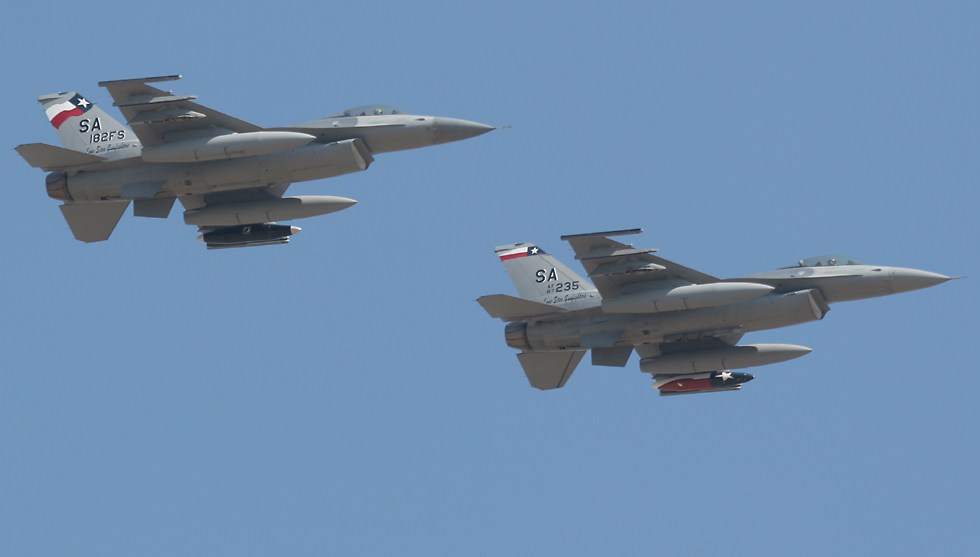
F-16 Fighting Falcons from the Texas air national guard open the show each year, usually timing their passes to perfection to coincide with the singing of the national anthem, and then sometimes doing a nice banked pass for the crowd. |

Midland is a large show, so each year it's able to get a military tactical demonstration from the air force, the navy or sometimes both. This year it was the turn of the air force with their A-10 Thunderbolt II, which does a very entertaining display by banking, turning and diving in front of the crowd, with the additional enhancement of lots of dynamite and gasoline pyrotechnics out on the field as it does mock bombing and strafing runs! |
